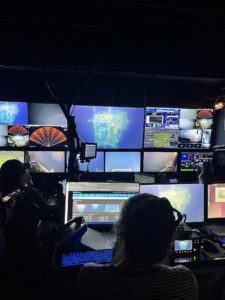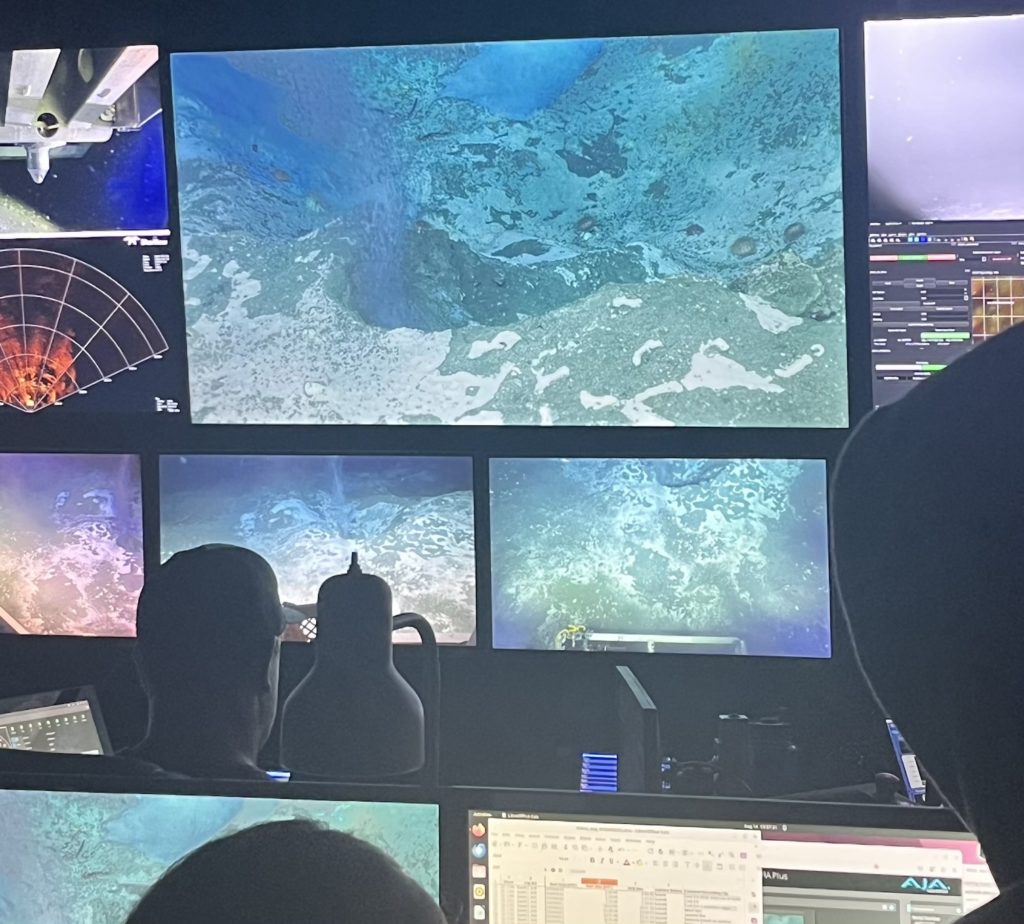
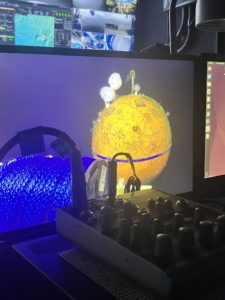
August 14th, 2025
Today during a dive relocating the digital still camera (CAMDS) at Southern Hydrate Ridge, there were newly active methane seeps! They were releasing a lot of bubbles, more bubbles than I have seen from the methane seeps I saw a couple days ago. At first they didn’t know where to put the CAMDS. but after seeing the new area of significant bubble emissions, the camera was placed to image that area over the next year.
For today’s student meeting, we heard Adam, a WHOI engineer, speak about his career path. He also gave some advice to us about enjoying our youth and exploring the world while we can. Today’s student meeting was earlier than usual, so I had some free time to sit by the bow and enjoy the sun.
During my second shift, I worked on code to look at the TMPSF raw data. I took a short break to look two porpoises swimming around the boat. They bobbed up and down along the trail created by the Atlantis. Then a Jason dive started midway through the shift. It was a dive to add a recovery line and float on the Deep Profiler Mooring at the Oregon Offshore site. On my way up to the van, I saw something out of the ordinary. In the far distance I saw…land! I think it’s been over a week since land was visible on the horizon. I gazed at the distance for a moment before entering the van.
It was a quick dive, we only went to descend around 80 meters in depth before finding the bright orange Deep Profiler mooring. Once the shackle was fully secured with the screw and push pin, Jason backed up and deployed the recovery line. Jason was recovered on the deck.
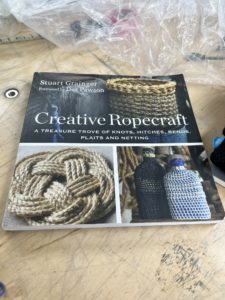
August 13th, 2025
During my first shift we waited for the weather to calm before doing any operations. Sitting at the work station while the waves are rocking the boat for a shift is challenging. My headaches come and go throughout the four hours. I found a book of knots, hitches, bends, plaits, and netting that helped keep me busy. Stepping out on the deck for fresh air was nice too. It was really cloudy but there was no rain. For breakfast, we had French toast and frittatas.
After my shift ended, I went to my berth to take a quick nap before today’s student meeting. This afternoon we got a tour of the navigation bridge. Molly, the Chief Mate, showed us the control board and how it maneuvers the ship and Derek, the Captain, showed us some of the features of the sonars and electronic mapping.
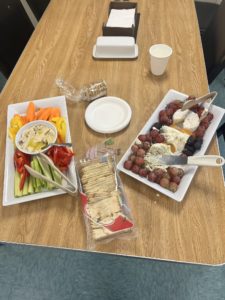
I headed down the stairs and walked into the mess deck for Cheese O’ Clock. Today’s assortment was a plate with veggies & hummus and a plate of brie, cream cheese, blue cheese figs, and grapes. There are always crackers on the side during Cheese O’ Clock.
My second shift started out in the Jason van. I was “sea” logging today and watched as the vehicle latched on to the package (shallow profiler) and hoisted up Jason and the package. Once the crane swung back over the ship, I saw crew members guide the heavy package and strap it down to the deck with ratchet straps.
The next dive happened an hour later. We headed to the van and watched as Jason latched on to the undervator. The vehicle went into the water and the crew started to put the yellow floats (lemons) onto the tether. The waves were strong , which caused the tether to have slack and whip back up. The extra slack combined with the waves caused the tether to whip under and up Jason. There were bubbles coming out of the hydraulics and the brow camera was unavailable. They recovered Jason and the undervator onto the deck as soon as they could and assessed the damage.
August 12th, 2025
Today I woke up pretty early. I think the naps I took during transits have done their job and helped me catch up on my sleep. I went to the main lab and found out that our original plan of going to Southern Hydrate Ridge had changed. There were too many krill in the water and they were getting in our intake system! So the new plan is to head to Northern Hydrate Ridge.
Today, I was able to see a whale up close for the first time. It surfaced on the starboard side and further into the horizon there were a lot more breaching.
During the Jason dive today, there was a lot of marine life at the seafloor. We saw a group of hagfish eating a fish. Earlier in the dive, there was a fish that was caught in one of the baskets of Jason. The pilot used the manipulators to grab the fish to set it free, but I think during the process the fish got hurt. We wondered if it was the same fish getting eaten by the hagfish… hopefully not.
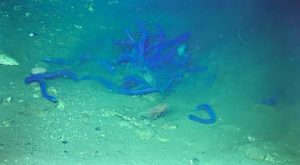
Chris, the pilot, was kind enough to let the students drive Jason! It was awesome and also scary. There were three joysticks. One controls the up and down (Y axis) movement of the vehicle, one controls the lateral, forward, and turns (X axis) of the vehicle, and one controlled the camera.
We also got to see the methane seeps. It looked like a cave entrance, and if you looked very carefully, there were bubbles rising from the cracks. Ice also formed in some of the cracks. There was a slight purple hue to the ice formations.
One of my favorite sights was the comb fish. I saw purple and clear comb fish. They, resemble a sea cucumber. When they moved across the screen, they glow a rainbow/iridescent color. It is magical.
August 11th, 2025
During my morning shift we were still waiting for the waters to calm before deploying Jason. It was relayed back to us that Jason would be doing a test dive and the official dive would start after breakfast. Today, for our student meeting we got to meet Derek the Captain of the Atlantis. He told us about how ship life shapes his lifestyle and some stories about his time out at sea. We got to see the front of Alvin, the deep-ocean research submersible that can reach depths of 6.500 m. Alvin had cameras and manipulators similar to Jason. It’s amazing to think that scientist have been able to go down to extreme environments like the hydrothermal vents.
During my second shift, there was a short Jason dive to the Slope Base Deep Profiler mooring. The ROV attached a ring with a shackle that was connected to a line on Jason through a loop on the Deep Profiler’s float at the top of the mooring. Then to secure the shackles, there was a screw that went through the ends of the shackle and a push pin was placed at the end of the screw. Once that was finally in place Jason was recovered.
There was a short break until the next dive, so I went to dinner earliy. I had beef sirloin, potatoes, and rice. The meals here are delicious. My shift ended in the control van – Jason was doing some work on the Slope Base Shallow Profiler.
When night came, I went out with some of the students to look for the metor shower. Out at sea,the stars are much more visible. It’s been over a week since we sailed from Newport and every time I go out to the deck I’m in awe.
August 10th, 2025
To prepare for a long transit, you need to note a few things. Medication is helpful and as I’ve mentioned before, it’s recommended to take it before the transit begins. Sometimes if it’s really bad I will put on some nausea wristbands. Before this trip, I didn’t know that they existed, but they are a wristband with a nub on the inside that pushes on a pressure point and helps alleviate nausea. I don’t know how much they help but it doesn’t hurt to have them on. However, you should take them off before doing lab work. One time, I was filling up a jug of milli q water from the hydro-lab and when I rested the jug on my arms to pour the water into another container, it felt really weird on my wrist. Lesson learned.
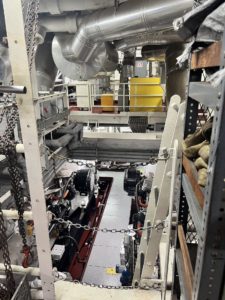
Credit: N. Liew, Queens College, V25
Strapping down equipment is a must! Since the beginning of the trip, the crew has given us bungee cords that we hook on to bolts in the tables and they help keep our belongings stationary. Avoiding screens can help a lot. Stay hydrated! If you can keep down food, crackers are a safe bet. Laying down and taking naps is a game changer. I usually wake up feeling better than I did when I fell asleep. Apparently, the waves doubled in size during the last 21 hour transit.
We had an engine room tour today lead by First Assistant Engineer Greg. He took us to see various parts of the engine rooms below deck. It was really loud, so he handed us ear plugs before going in. He showed us the thrusters that help control the boat when in deep ocean water. I was surprised to find out that it takes around 5,000 gallons of diesel to keep the ship moving for one day!
August 9th, 2025
Today was a slow day on the ship. My morning shift was mostly in the main lab. There was supposed to be a dive happening around 5am but there were some technical difficulties and a ground fault warning so the dive was delayed.
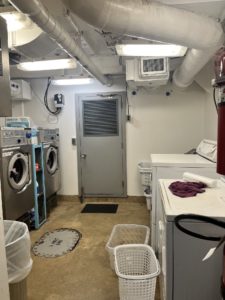
I remember during the first day on the Atlantis I explored the ship and somehow found the laundry room. Today I attempted to find it again. I forgot to pack a laundry bag so I settled for a plastic bag I had in my suitcase. I remembered hearing that the laundry room is below the main lab so I looked for a staircase down. In the ship hallways I know of two staircases. Both lead up to the Mess deck, but only one of the staircases leads up a floor and down a floor. So I went down one flight of stairs and saw an old elliptical sitting at the end of the hallway. I looked around and didn’t see a laundry room. I went down one more set of stairs and ended up by the freezers. When I got closer to the end of the hallway I heard some familiar clanking sounds and I finally found the laundry room. It had two washers and three dryers. Between the two washers was a box of enzymatic detergent powder. On the washer it said that you only needed 1/3 of detergent you usually use at home. I normally use liquid detergent so I eyeballed the scoop of powder into the pre-wash and wash. I came back 30 minutes later and the cycle was done! I moved my clothes into the dryer unit. It opened like an oven door. I put some dryer sheets in there that I found sitting below the box of detergent. There was a warning on the dryer saying not to use high heat because it’s a safety hazard. So I put the cycle on low and came back around 40 minutes. My clothes were now fresh and clean. Turns out doing laundry on a ship is pretty similar to doing laundry at home.
Later on in the day we are going to be in transit again. It is going to be around 20 hours. I am a bit nervous because apparently the weather is going to be rough over the weekend. So I made sure to take my medicine after lunch and took a nap. The transit waves are expected to be 9ft.
August 8th, 2025
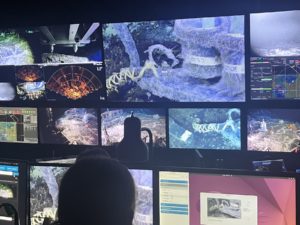
This morning I woke up pretty tired. I think the random naps I take whenever I have the chance is slowly adding up and making it hard for me to fall asleep at night. I could tell from the rocking of the boat that we were in transit. I decided not to take dramamine during this transit because after that day of transit to Axial Seamount my body had adjusted itself to handle the motions (I hope…). When I got to the main lab there was a CTD cast just beginning.
When working out on the deck there are three things you need to wear; a hard hat, steel toed boots, and a life vest. Setting up the CTD means opening all 24 niskin bottles and latching them to their appropriate hooks so that they stay open until they are in the water and reach their target depth. This cast’s dive was short so I got to do both deployment and recovery. For deployment some knot tying knowledge is needed. The bowline is a very handy knot and can handle a lot of tension but is also easy to undo. For recovery, it is helpful to hook on to the side railings of the CTD because it gives us more control over where the CTD lands on deck. Soon after the CTD was hosed with fresh water, some samples were taken out of it.
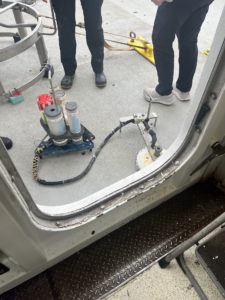
A JASON dive also happened in the morning shift. It was around 12 hours which is the longest one I’ve seen so far. Around the later half of my first shift, I headed up to the van and logged the deployment. By the time my shift ended we were at the bottom of the seafloor! It was my first time seeing the seafloor on the monitor. The JASON team was trying to find a flat spot to put the package on. The next Jason Dive was during my second shift and it was super cool. I got to see ASHES and saw the chimney of Mushroom vent. The dive was a recovery of an osmotic water sampler. It was really fuzzy and had a bunch of growth on it. JASON hovered over one of the vents and collected some of its fluid. When the niskins returned to the surface I was in the wet lab with the students helping Lacie (graduate student) get her samples. While that was happening, they were also scraping off some of the bacteria from the osmotic water sampler for DNA testing in the future.
August 7th, 2025
After a day of transit, the ship arrived at the Axial Base. My morning shift began in the control van. To get ready for van duties I make sure to bring my water bottle, a jacket, and a beanie. It is pretty chilly in the van because the computers can heat up from all the activity. There was a dive going on and when I stepped into the dark room, I saw the instrument in sight. JASON’s manipulators were plugging in cables to prepare the shallow profiler for recovery. It was my first time video logging and taking pictures during a dive which was exciting. There are five screens to be aware of and different camera angles that can be switched around. When the instrument is in view it is important to record for the highlight videos later on.
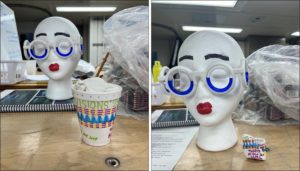
There’s a student use computer that has Final Cut Pro on it. Emily was showing me some of the features on the program that can be helpful for my video project. I am still thinking about what I want to do for my project. The CTD instrument is pretty interesting to me, as well as the hydrothermal vents. The ASHES vent field was about to be our next stop so hopefully tonight I can go up to the van and check out the dive.
The styrofoam cups were sent down for the dive in the afternoon. They were in a mesh bag zip tied to the CTD rosette. The mannequin head stayed though. But maybe it’s for the best since the motion sickness glasses sit perfectly on it. When the CTD came back up my cup returned shriveled and tiny.
On my second shift there was a Jason dive happening in the van. The junction boxes by Axial Seamount were getting swapped out. During the descent I saw an orange squid that squirted an orange substance. I noticed that there were a lot more sea creatures during this descent than any of the others I’ve seen so far. I am excited for tomorrow because there will be a JASON dive to the hydrothermal vents!
August 6th, 2025
Last night I heard from a couple of the crew that the transit to Axial Seamount would be rough and to take medication before sleeping. So after I observed sample testing for chlorophyll and the video grabbing station in the control van, I headed to my berth to shower and go to sleep. I slept until the rocking of the boat ramped up.
My shift started and it was a very quiet day. Because we were in transit there wasn’t much to do. I started decorating my styrofoam cup to distract me from the growing headache. When the CTD cast to 2600 m happens at Axial Base and the styrofoam cups go down, the pressure will cause the cups to shrink. I think this will be a lovely souvenir of this experience when I get home. Eventually the headache and nausea won and I went to my berth for a quick rest. I woke up around the end of breakfast time and made my way to the galley. I looked out the circular window by the tables and saw the big waves and trail of the ship.
August 5th, 2025
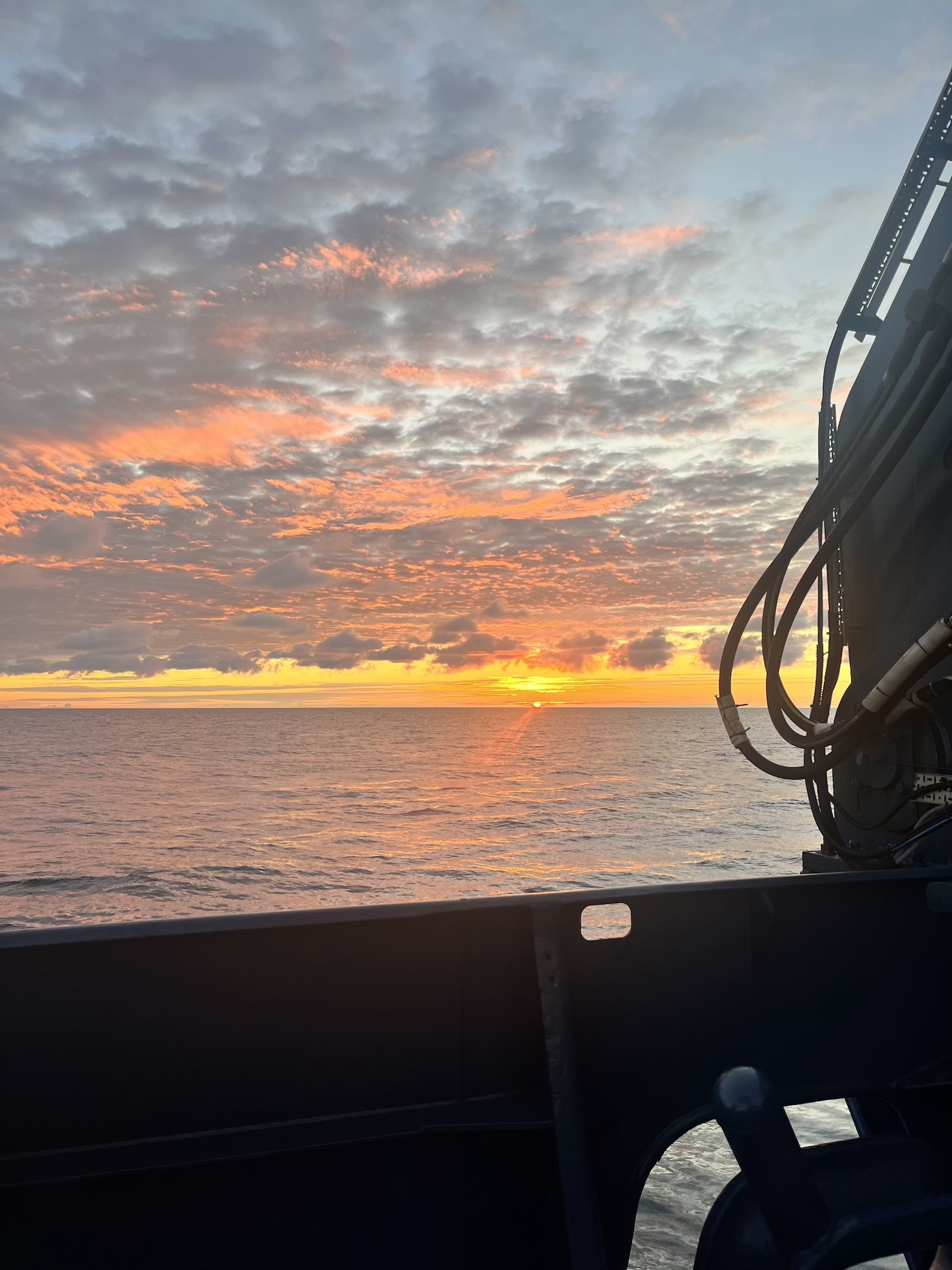
Today I woke up to the ship in transit from the Oregon Offshore to Slope Base. I slept a little too well and was awoken by Ari reminding me our shift was starting soon. The shifts are 4 hours on, 8 hours off. So I got ready in the dark to not wake up Megan since she came back from her shift not too long ago. I wondered how to balance my shifts, meal times, and sleep while I headed up to the main lab.
I made sure to check “The Board of Lies,” the white board with times of dives and other events scheduled for the day. During transit we worked on water samples from the last dive. I was in the wet lab and saw the process of bottling up the samples to test for salinity, chlorophyll, nutrients, and dissolved oxygen. We had some time till the boat was stationed and enjoyed the pink and orange sunrise on the dock. It was a beautiful sight, it was just the pink, orange skies, the water, and if I looked carefully I could see some landscapes far ahead. The headaches start to kink in when using my laptop during transit. The screen starts to shake and the side to side motions of the boat are felt more on an empty stomach.
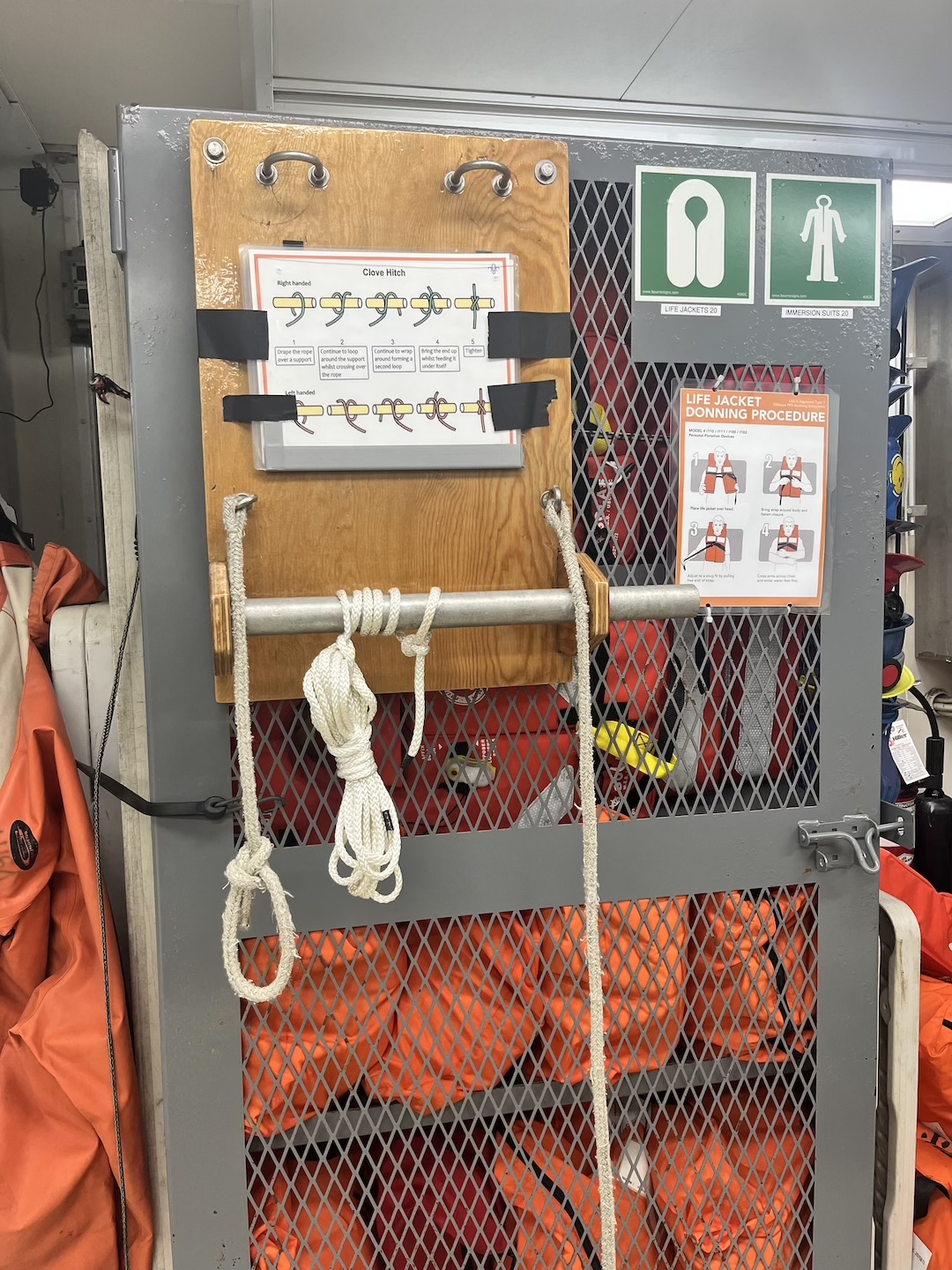
Once the boat was stationed at Slope Base we set up and deploy the CTD into the water. In the main lab there were ropes that could be used for practicing knots. I had to brush up on my bowline knot since that was needed to help tie the rope to the eye that was screwed into the deck.
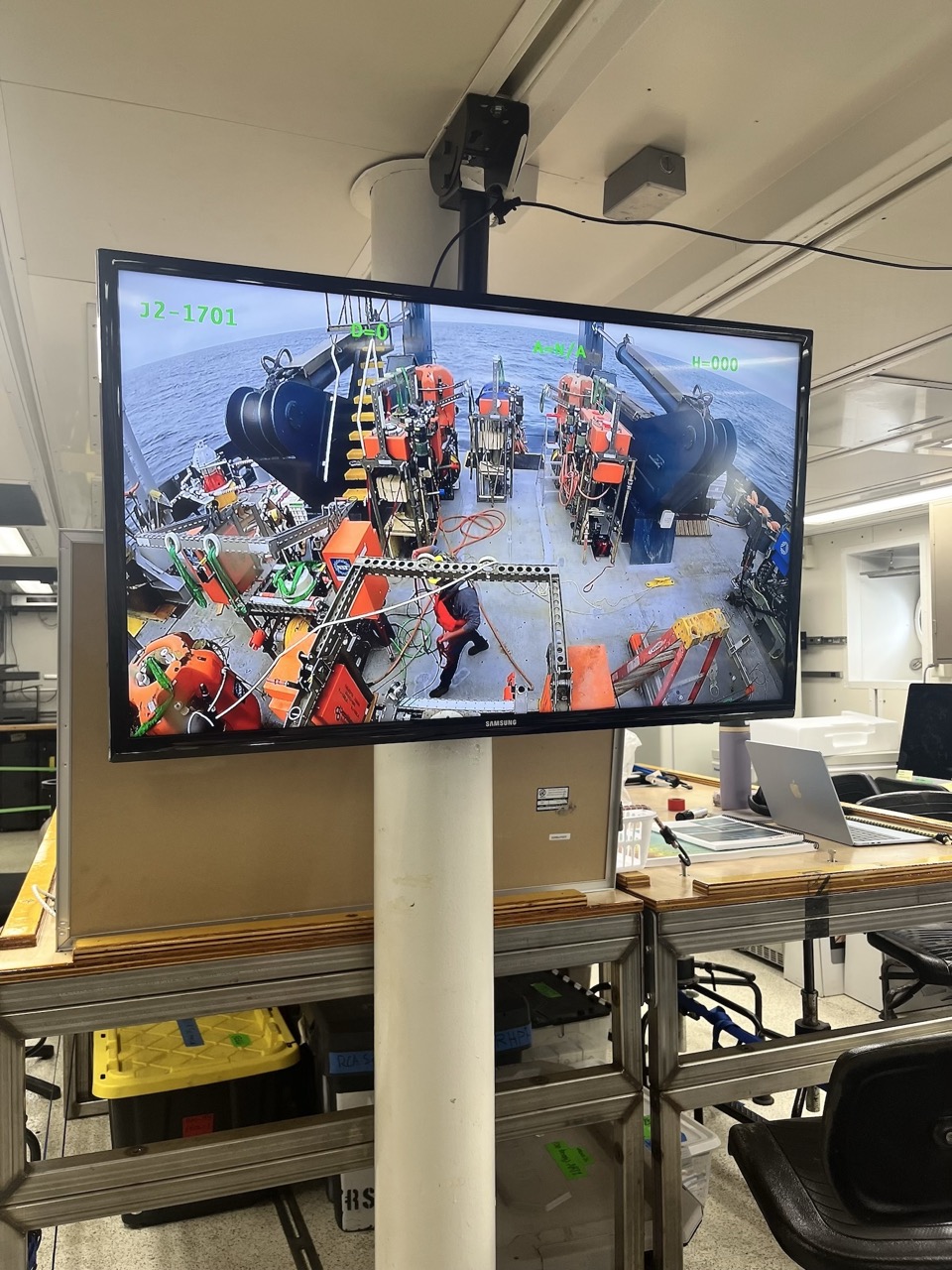
Another feature of the main lab is the monitor of the JASON dives mounted on a pillar next to the work stations. I watched as JASON’s manipulators moved around parts of the shallow profiler. There was a red crustacean resting on the platform that the camera zoomed into. It scurried away moments after JASON grabbed the platform to prepare for recovery.
August 4th, 2025
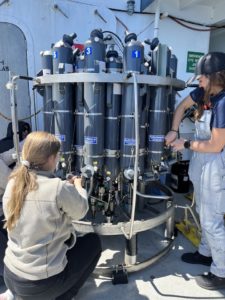
Today was the first day the Atlantis sailed to the open ocean. As we went through channel into the Pacific, I saw the beach that Nadia and I walked to last night. From the ship I could see how the waves had made a dent into the sand forming a semi circle.
The moment we got on the open ocean I felt the swaying of the ship from side to side. One of my concerns was seasickness, but luckily the Dramamine I took was doing its job. We had a couple tours today; the Jason ROV, CTD rosette with Niskin bottles, control van, the computer lab, and the wet lab.
For my first task, I was on iPad duty. I scanned the barcode of sample bottles and noted which Niskin bottle a water sample was collected from on the CTD. I even got to collect water samples from the Niskins.
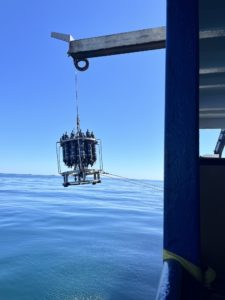
As dinner time approached, Emily and Yoochan helped cover my shift while I went to the gallery for a quick meal.
When I came back, it was time to clean up and head to the control van. Today Jason was deployed to recover one of the Shallow Profiler instrumented platforms. It was incredible being able to see the crustaceans and jelly fish pass by as Jason descended.
When we got to the Shallow Profiler 200 m deep 12 ft across platform, it was covered with life. I was shocked at how well the cameras could pick up life from meters away. I can’t wait for what’s in store tomorrow.
